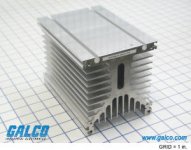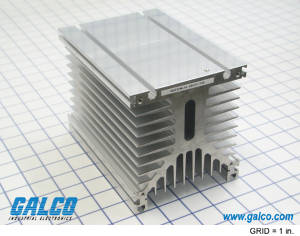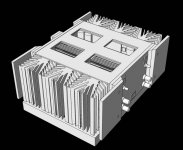Guys,
On the basis that I do an alternative layout for those who don't want to force cool, I would expect that the boards would be more than 'slicing the mosfets off each end.
In reallity to gain advantage the boards would need to be long with greater spacing between mosfets allowing a more even spread of heat along the length of the heatsink and thereby avoiding 'hot spots' which would be a problem if the mosfets remain at there current spacing.
Give me a couple of hours and I'll come up with some alternatives.
On the basis that I do an alternative layout for those who don't want to force cool, I would expect that the boards would be more than 'slicing the mosfets off each end.
In reallity to gain advantage the boards would need to be long with greater spacing between mosfets allowing a more even spread of heat along the length of the heatsink and thereby avoiding 'hot spots' which would be a problem if the mosfets remain at there current spacing.
Give me a couple of hours and I'll come up with some alternatives.
Only 100 watt? 🙂 🙂
It's a class-A amp, so it's basically 25% efficient. 100 watts output will need 400 watts of dissipation... Per channel...
......
So, our worst-case scenario F5 v3 with 8 transistors per channel, and then 16 in a stereo chassis, you come up with 768in^2, or 5.3 square feet (1.6 square meters) of heatsink required.
😱😱😱😱😱😱😱😱😱😱😱😱😱
So, a normal-looking, flat back heatsink, convection cooled is going to be staggeringly large. The heatsink profile will need to be much more complex. And probably fan-cooled.
Somebody please correct me if my back of the napkin calculations are incorrect.
It's more like 15% efficiency i think !
...I said it would be a beast....😀
When designing the board it looks easier than when you start juggling actual build options....
I am a big fan of the idea of separating the output boards and input boards. This would allow for people to make the standard SE build, mono-blocks and balanced cleanly. It sounds like there are a number of people (myself included) who are looking to do balanced builds, and a separate input board could be made to support a balanced option (probably would only need a few jumper locations). It also makes building mono-blocks more straight forward as well.
Separating the input and output boards would provide the maximum flexibility, at the expense of a little added cost. In the scheme of things, the added cost for the PCB's would be pretty insignificant.
My 2 cents.
Separating the input and output boards would provide the maximum flexibility, at the expense of a little added cost. In the scheme of things, the added cost for the PCB's would be pretty insignificant.
My 2 cents.
Last edited:
Andy,
you cannot posibly cater to everybody's individual design, or the effort is going to fall apart.
That is why PDaniel makes the boards as small as possible, and then everybody can run wires to whatever an ideal mosfet location may be on their hsink. (only the holes for soldering nice size wire need to be provided).
p.s. for the same reason, I did not make an issue about no scoring lines and having to cut the boards for a V2 version to fit my heatsink; I am trying to live with the group choices (or else, if not possible, do my own pcb).
you cannot posibly cater to everybody's individual design, or the effort is going to fall apart.
That is why PDaniel makes the boards as small as possible, and then everybody can run wires to whatever an ideal mosfet location may be on their hsink. (only the holes for soldering nice size wire need to be provided).
p.s. for the same reason, I did not make an issue about no scoring lines and having to cut the boards for a V2 version to fit my heatsink; I am trying to live with the group choices (or else, if not possible, do my own pcb).
6 of these, 3 on each side, ~15" deep stereo amp.
Good for 100W Class A, manufactured all over the world.
Do the crime, pay the fine.
Found the cut sheet here:
Semikron P3 Heatsink Data Sheet
These guys sell the heatsinks in the US. You have to ask for a quote, so not sure how much they run. They do look nice.
HEATSINK-KL-285P/180
6 of these, 3 on each side, ~15" deep stereo amp.
Good for 100W Class A, manufactured all over the world.
Do the crime, pay the fine.
Interesting heatsinks. Good for either convection or forced air.
I found the manufacturer's data sheets for those heatsinks. The item code is P3.
SEMIKRON >> Components >> Accessories >> Heat Sink
http://www.semikron.com/products/data/cur/assets/P_3_PS503012.pdf
Basically, for a 100W Class A stereo power amp with natural convection, you have to think the size of a Krell KSA150.
Say 19" wide, 8" high, and ~15" deep with front and back plates, about 100lb.
Say 19" wide, 8" high, and ~15" deep with front and back plates, about 100lb.
you must have about dobble amount of heatsinks for a stereoamp then 2 monoblocks. lower heatsinks are more efficent than tall ones.
Do the math , it cost more to "build" 2 chassis than one, no matter which way you slice it . Here we can buy used exotica for 2K, so guess what spending 2 K for DIY does not make much sense.
Andy,
you cannot posibly cater to everybody's individual design, or the effort is going to fall apart.
That is why PDaniel makes the boards as small as possible, and then everybody can run wires to whatever an ideal mosfet location may be on their hsink. (only the holes for soldering nice size wire need to be provided).
p.s. for the same reason, I did not make an issue about no scoring lines and having to cut the boards for a V2 version to fit my heatsink; I am trying to live with the group choices (or else, if not possible, do my own pcb).
Precisely, this will keep going around and around , i guess most here have never had a 100 watt class-a amp , it's monster size, monster heat , monster consumption.
Found the cut sheet here:
Semikron P3 Heatsink Data Sheet
These guys sell the heatsinks in the US. You have to ask for a quote, so not sure how much they run. They do look nice.
HEATSINK-KL-285P/180
Whats the cost on those sinks .... ?
Bottom line is it's easier to make mono blocks.
You mean more convenient, Hard to make room or justify 4 mono chassis plus cost...
Something like this JV ?
...from something i'm working on😎.
Errr.. Looks fantastic ....... I like .... 😉
Basically, for a 100W Class A stereo power amp with natural convection, you have to think the size of a Krell KSA150.
Say 19" wide, 8" high, and ~15" deep with front and back plates, about 100lb.
MY KSA200 was a PITA , special outlets and 1400watts constantly, nothing over 50 watt class-A is necessary for me.
Also available in the UK. Email for a price.
Heatsinks: 7000 series - 7200HS
http://www.gdrectifiers.co.uk/uploads/Heatsinks_for_isolated_modlues.pdf
Heatsinks: 7000 series - 7200HS
http://www.gdrectifiers.co.uk/uploads/Heatsinks_for_isolated_modlues.pdf
- Status
- Not open for further replies.
- Home
- Amplifiers
- Pass Labs
- F5 Turbo Circuit Boards



